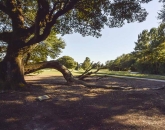 One advantage that Sentosa has in helping to get getting their putting surfaces into pristine shape, aside from the abilities of its 100 green-keeping staff, is its use of Subair. A nifty system installed under all the greens of the Serapong Course, Subair essentially sucks away the moisture out of the greens and then blows air into them, which helps keep them healthy and playable.
One advantage that Sentosa has in helping to get getting their putting surfaces into pristine shape, aside from the abilities of its 100 green-keeping staff, is its use of Subair. A nifty system installed under all the greens of the Serapong Course, Subair essentially sucks away the moisture out of the greens and then blows air into them, which helps keep them healthy and playable.
“Within minutes of a downpour our greens can be dry again. It costs around US$100,000 to install each green with it but when you have visitors paying up to S$500 (approximately HK$2,500) for a round they should expect a well-maintained golf course.”
A somewhat controversial practice that Downie has ushered into the club during his tenure has been the practice of auditing of members’ handicaps.
“We randomly pick 12 members and check to see whether the number of cards they’ve submitted correlates with the number of times they’ve played,” he says. “We know how many times they’ve played because they have to sign in. If the numbers don’t match then we fill in a card on their behalf. Whatever was the lowest card they put it that month we’ll match it. So it becomes public and the handicap is adjusted. Before it was pretty ridiculous: winners with 46 [stableford] points was common.”
Needless to say, sandbagging is quickly becoming a thing of the past at Sentosa.
When Downie speaks, whether it’s about his plans to install a pot bunker by the 1st green, to upgrade the Tanjong Course, the club’s second track, introducing caddies to the club, or simply ensuring that members’ handicaps are kept up to date, it becomes blindingly clear that he is not only exceptionally good at what he does, but he carries in his head the vision of what needs to be done for the benefit of all. The Japanese have a philosophy for what he epitomizes: Kaizen—continuous improvement.
“I’ve done this for long enough, over 30 years, and it’s not a job. This is my life—and it’s a great life,” he says as we put down our glasses for the final time of the evening. “It’s a lovely way to come to work. When I get through these gates every morning I think, ‘Wow. I get paid to do this?’
“To tinker with a golf course…it’s something I’m passionate about. I come out here and say ‘OK, how do I make this place better?’”
Pages
Click here to see the published article.











